
There are many strategies in building plant sales, whether through
imaginative displays, product branding, specialty growing or niche
marketing.
There are many strategies in building plant sales, whether through imaginative displays, product branding, specialty growing or niche marketing. Registrants on last fall’s CanWest Hort Show specialty nurseries bus tour sampled a little of each of them during a daylong outing.
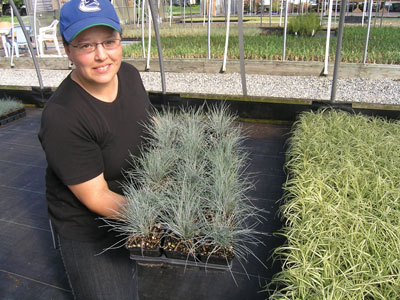 |
|
| PEPINDALE: Manager Mollie Gordon with ‘Pepindale Blue Advertisement
|
PEPINDALE NURSERY: NICHE MARKETS
■ Ornamental grasses are one of the fastest growing market sectors, and one of the leading West Coast suppliers is Pepindale Nursery, located in Aldergrove.
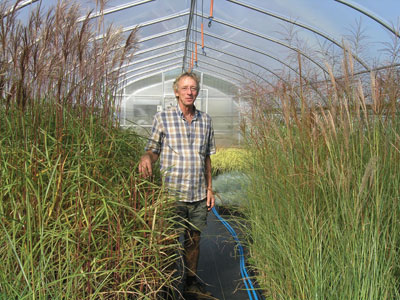 |
|
| PEPINDALE: co-owner George Feddes.
|
Owners Lea and George Feddes established the business in 1997, and embarked upon a steep learning curve. “What makes it so challenging is that there is very little information on ornamental grasses out there,” says George.
It’s much different if you’re growing poinsettias or petunias, he says, because there’s been a lot written about them.
“We went through a lot of trial and error for about five years. Now we have the experience behind us and it’s much easier to do.”
The farm has an outdoor production area along with 24,000 square feet of greenhouses. Also featured is a large display bed with the most popular varieties.
A good memory is a blessing with these crops. “You’ve got to remember how a particular grass looked last year,” says George. And then by looking at this year’s crop, “you can tweak the fertilizer” to get those same results.
All the plants are brought into the greenhouses in the winter to keep them out of the rain. “It almost never stops raining here,” George quips. “You don’t want the plants sitting in soil that is over-saturated. The rain washes the nutrients out of the soil.”
One of their big sellers is miscanthus gigantus, which is being studied as a biofuel. They shipped about a half-a-million plants last year. “There’s a huge market,” says George, and it’s growing.
TANGLEBANK COUNTRY GARDENS: MASTER MERCHANDISER
■ Tanglebank Country Gardens is a boutique retailer in Abbotsford. Owners Arnold and Brenda Falk launched the business in 1996 on the 20-acre site. Featured are several display gardens, including a water-wise section that gets watered-in when first planted and then left alone the rest of the season.
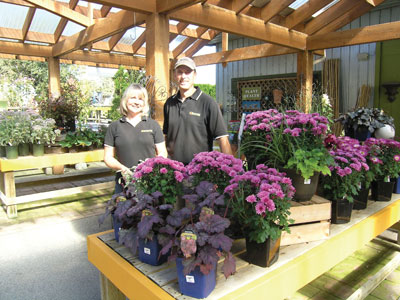 |
|
| TANGLEBANK: Brenda and Arnold Falk of Tanglebank Gardens, home to impressive display gardens and imaginative merchandising.
|
The spacious display gardens show customers the potential of 4” plants, and how they can be combined.
“It is our goal to make this world a more beautiful place … one garden at a time,” notes the company’s website.
In addition to annuals, perennials, ornamental grasses, trees and shrubs, Tanglebank also has a gift store with a variety of distinctive products.
Tanglebank hosts numerous educational workshops and seminars and also offers a landscape design service.
VALLEYBROOK GARDENS: THE ART OF BRANDING
■ Valleybrook Gardens has long demonstrated the effectiveness of branding perennials. It is the home of the Heritage Perennials’ trademark blue pots, and Jeepers Creepers and Rock Stars, all household names within the dedicated gardening community.
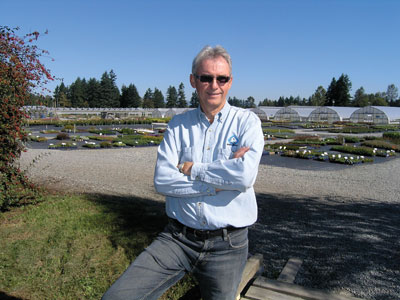 |
|
| VALLEYBROOK: John Schroeder, president of Valleybrook Gardens: “Our job is to help our customers sell more plants.” |
Recent automation investments in the potting and transplant areas have been effective. “We’re able to work with more plants, but with the same number of staff,” notes company president John Schroeder.
With 25 acres of land and some 200,000 square feet of greenhouses at its Abbotsford location, continuous improvement in efficiency is important. The company also has 30 acres of production in Ontario.
Valleybrook developed its own barcoding system in the early 1990s to keep track of crops. The company has 2,000 different varieties, and uses its own trucks for most deliveries. It has 1,000 retailing customers throughout North America, mostly independent garden centres.
Plants are housed in cold frames in the winter, and most of the structures have heaters.
Customer satisfaction is job one. “All staff can flag a product they don’t feel is up to our standards,” says Schroeder. “Our job is to help our customers sell more plants.”
PEEL’S NURSERIES: SPECIALTY CROP SPECIALIST
■ Native plant propagation and production is the focus of Peel’s Nurseries Ltd., located near Mission in the picturesque Hatzic Valley. It grows a variety of native plants used in commercial and residential landscapes, in habitat and wetland restor-ation, and in parks and along highways.
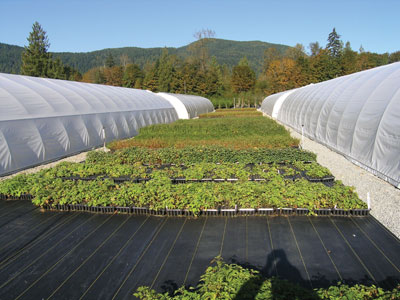 |
|
| PEEL’S NURSERIES: Outdoor production between a couple of greenhouses.
|
Products range from bare root and plugs, to containers and hand-dug or spade-dug trees.
Owners Bruce and Lauren Peel established the farm 20 years ago. They buy some plant material, but prefer to grow as much as they can. “We try to be as reasonably self-sufficient as economically feasible,” says Bruce.
It’s a good location for them, as the soil is good quality though not too deep. It has about 10 per cent organic matter content. It’s a clay loam with an underlying of heavy clay, “quite typical of this area.”
Is it the best soil for their product line?
While sandy soil would make extracting the bare-root material easier, it would have to be irrigated more frequently.
“The upside of clay soil is that it holds moisture quite well,” says Bruce. The downside of clay, however, is that it’s hard to remove the soil from the roots.
It’s not a cold valley, but it can be “frosty,” says Bruce. “It will snap the trees into dormancy a little faster in the fall.” They generally don’t experience much cold injury.
Bruce says he likes growing trees and especially enjoys working outdoors. “It’s a great way to earn a living.”
This year’s CanWest will be held Sept. 28-29, with bus tours on Sept. 30. It will again be held at the Vancouver Convention Centre.
Print this page